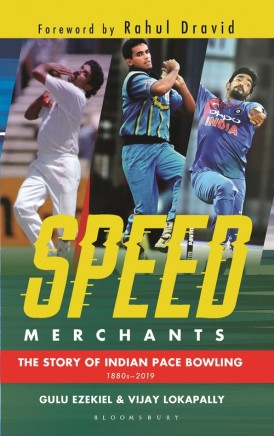Speed Merchants
Martin Chandler |Published: 2020
Pages: 207
Author: Ezekiel, Gulu and Lokapally, Vijay
Publisher: Bloomsbury India
Rating: 4 stars

As co-author Gulu Ezekiel points out in the very first paragraph of the author’s note that introduces Speed Merchants no one has previously written a book about Indian pace bowling. On a wider level that most exciting of cricketing disciplines has, of course, been the subject of a good deal of the game’s literature without very much of it dwelling for very long in India. Yet as we fast approach the third decade of the twenty first century the Indian pace attack is as potent as any in the world game, so this look at where the likes of Jasprit Bumrah, Ishant Sharma and Mohammed Shami came from is long overdue.
The two authors are both experienced writers and, without wishing to embarrass them, are old enough to have served their writing apprenticeships in an era when an Indian opening attack would consist of a couple of batsmen asked to bowl a handful of overs of gentle medium pace in order to get the ball ready for whichever combination of wily spin bowlers happened to be on duty in any particular game.
So they have come up with the splendidly titled Speed Merchants, a book that comes in two distinct parts. Part one takes the story from the earliest days of cricket in India up to 1978, and the second on from there to the present day. The first and rather lengthier part is contributed by Gulu, with Vijay Lokapally’s duties beginning with a gentle introduction in Chapter 5, Nation of Speedsters, followed by the appropriately entitled Kapil Arrives.
There will doubtless be many readers of Speed Merchants who will be entirely unfamiliar with the days before Kapil, and despite what I like to think is a wide ranging interest in the history of the game my knowledge of the exploits of Indian pace bowlers before the early 1970s was limited to what I had read about Amar Singh and Mohammad Nissar, both of whom were lauded by the English players and writers who watched them in England in the 1930s.
There is a good deal of material to be found about Amar and Nissar, but it is bits here and bits there without a single seamless narrative. Finally Speed Merchants has done justice to these two great bowlers and their story is, as I expected it to be, the book’s highlight. Impressive too are the credentials of Ladha Ramji, who I knew was another pace bowler and Amar’s older brother, but I had not previously realised just what a fine player he was and, as a bowler, how fearsome an opponent he was at his best.
The first part of the book also adds some interesting background to men who were previously little more than names to me. There is ME Pavri from Victorian times and, after Amar and Nissar but before Kapil, a cast of if not thousands then certainly more than I expected, led by the likes of Dattu Phadkar, Surendra Nath, ‘Tiny’ Desai, Rusi Surti and, a man I remember very well, Syed Abid Ali, all thoroughly deserving of a more detailed look at their contribution to the game than has hitherto been given. None after Nissar were genuinely quick, but all play their part in the history of Indian pace bowling.
Moving on to Kapil and the years that followed him Vijay had a rather different task, so many words having already been written about those who have made their names in the modern era, and whose deeds his audience will largely be familiar with. His is therefore more in the nature of a whistlestop tour than one that pulls into every station on his route and is a most readable summary. The big names are not ‘done to death’, and at the same time none of those who have played a part are overlooked,
That images of Kapil, Zaheer Khan and Bumrah adorn the eye catchingly colourful front cover is unsurprising in the age of the IPL, and as a concession to those of us who do not care greatly for the game’s shorter format there is a much more soberly designed rear cover that bears an image of Amar and Nissar. All in all I think I have to concede that the publisher’s designer, and whoever sourced the book’s photographs, have both done an excellent job and one which does justice to the quality of the narrative within.
The above said there are disappointments, particularly bearing in mind the book has come from the stable of a major publisher. There are a number of typos, particularly in Vijay’s chapters, most of which I would have expected an editor or proof reader to pick up and whilst I do not intend to list them as an example of how avoidable they were Chapter 13 is entitled Speed in Vouge, jarring at the best of times, and the more so in the larger title font. The lack of an index to an essentially historical book is disappointing and quite why what is an otherwise interesting statistical section is spoilt by there being no First Class figures for anyone who made their debut after Abid Ali is an omission with no obvious explanation. Those grumbles aside however the penning of Speed Merchants was still a more than worthwhile exercise that fills a significant gap in Indian cricket literature.






Leave a comment